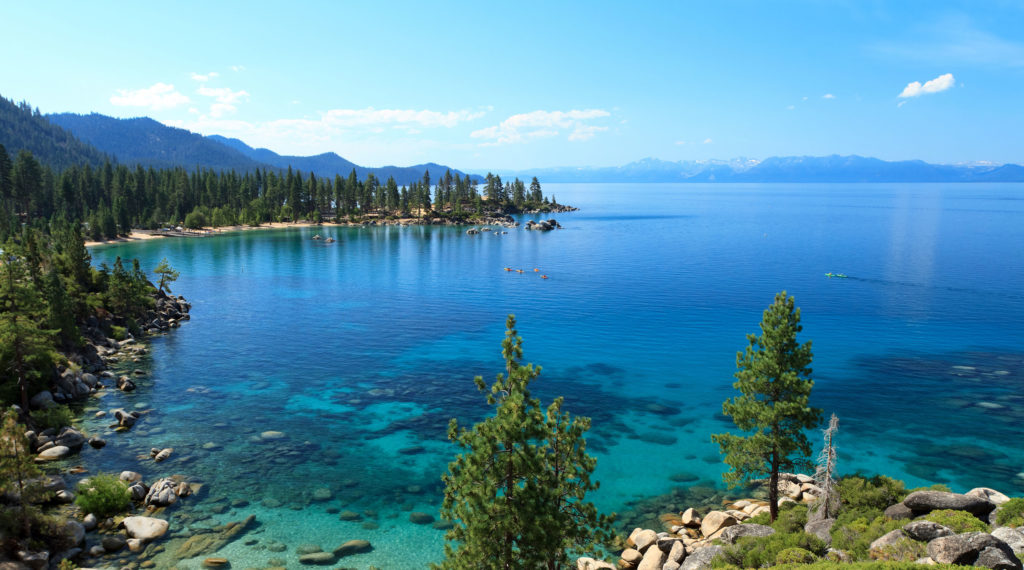About Lake Tahoe
Lake Tahoe is located in the states of California and Nevada, with two-thirds in California. It is fed by 63 streams and two hot springs. The Truckee River is Tahoe’s only outlet and flows from the dam in Tahoe City east through Reno and eventually drains into Pyramid Lake in the Nevada desert. From there, it evaporates into the atmosphere.
Lake Tahoe sits at an average surface elevation of between 6,223’, its natural rim, and 6,299.1’ the top 6.1’ of water is controlled by the dam in Tahoe City and holds up to 744,600 acre feet of water.
However, water releases are not permitted when the lake surface level falls below the natural rim at 6,223.’ The lowest lake level on record (measured since 1900) was 6,220.26’ on Nov. 30, 1992.
Clarity of the Water
 The University of California, Davis, operates the Tahoe Environmental Research Center, which monitors, among other things, the clarity of Lake Tahoe.
The University of California, Davis, operates the Tahoe Environmental Research Center, which monitors, among other things, the clarity of Lake Tahoe.
Clarity has been measured since 1968 using a Secchi measurement, which is the point below the lake surface at which a 10” white disk disappears from view. The annual Secchi depth is comprised of about 25 readings throughout the year.
The waters of Lake Tahoe were clear to an average depth of 69.6’ in 2008. This keeps the clarity measurement in the range where it has been for about the past eight years.
In 2008, UC Davis reported that data since 2001 suggested lake clarity was not declining as fast as it had been. That encouraging finding is supported by the 2008 average, which is nearly identical to the 2007 average of 70.1 feet.
Lake Tahoe is losing clarity because of fine (microscopic) sediments entering the lake and algae growth (fueled by nitrogen and phosphorus).
Blue Color
The lake water appears blue in color as other colors in the light spectrum are absorbed and blue light is scattered back. In addition, under the right conditions, the Lake surface can reflect the color of the sky.[1]
Native Inhabitants
Lake Tahoe and about 10,000 square miles of land surrounding the lake were once home to the Washoe Indians, the native peoples to Lake Tahoe. They once wintered in the Carson Valley and spent their summers on the shores of the lake hunting, fishing and gathering foods for the winter.
About 1,500 members of the Washoe Tribe of Nevada and California live on tribal lands known as “colonies” scattered in the Reno, Carson Valley and Gardnerville areas of Nevada and in Woodfords in California. An active tribal government continues to lobby for a land base in the Lake Tahoe Basin. They also work with federal and state agencies and private land owners to protect locations important to Washoe Heritage.
Discovery
The first recorded discovery of Lake Tahoe by white explorers was on Feb. 14, 1844, when John Charles Frémont and Charles Preuss spotted the lake from atop Red Lake Peak. Frémont named the lake “Mountain Lake” and then called it “L. Bonpland,” in honor of French botanist Aimé Jacques Alexandre Bonpland. The name was changed to Lake Bigler in 1857 in honor of Calif. Gov. John Bigler. The lake was renamed Tahoe in 1945.
Tahoe is a mispronunciation of the first two syllables of the Washoe’s word for the lake – Da ow a ga, which means “edge of the lake.”
Snow Conditions
How much snow did Lake Tahoe ski resorts get? Find the latest snow reports from OntheSnow for Lake Tahoe mountains, updated daily throughout the winter season with new snow totals for the last day or three days. See Lake Tahoe ski resorts’ open/closed operating status, upper mountain and lower mountain base depths, number of open lifts, and total amount of open acreage.
Sources: Tahoe Environmental Research Center, U.S. Geological Survey, “Tahoe Place Names” and David Antonucci (denoted by 1).
